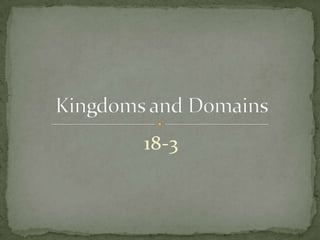
Six kingdoms and three domains of life
- 1. 18-3 Kingdoms and Domains
- 2. The six kingdom system of classification includes the kingdoms Eubacteria, Archaebacteria, Protista, Fungi, Plantae and Anamilia. The six kingdoms of life
- 3. The three domians are the domain Eukarya, which is composed of protists, fungi, plants, and animals; the domain Bacteria, which corresponds to the kingdom Eubacteria; and the domain Archaea, which corresponds to the kingdom Archaebacteria. The three domain system of classification.
- 4. Molecular analyses have given rise to a new taxonomic category that is now recognized by many Scientists. The domain is a more inclusive category than any other—larger than a kingdom. Domain
- 5. The members of the domain Bacteria are unicellular and prokaryotic. Their cells have thick, rigid cell walls that surround a cell membrane. The domain Bacteria corresponds to the kingdom Eubacteria. These bacteria are ecologically diverse, ranging from free living soil organisms to deadly parasites. Bacteria
- 6. Archaea are also unicellular and prokaryotic. They can live in extreme environments such as volcanic hot springs, brine pools, and black organic mud totally devoid of oxygen. The domain Archaea corresponds to the kingdom Archaebacteria. Archea
- 7. The domain Eukarya consist of all organisms that have a nucleus. It is organized into the four remaining kingdoms of the six kingdom system: Protista, Fungi, Plantae and Animlaia. Eukarya
- 8. Protista is composed of eukaryotic organisms. This kingdoms members display the greatest variety. Most are unicellular, but some can be multicellular, like some algae. Protista
- 9. Members of the kingdom Fungi are heterotrophs. Most feed on dead or decaying matter. The most recognizable fungi, including mushrooms, are multicellular. Some fungi, such as yeast, are unicellular. Fungi
- 10. Plantae are multicellular organisms that are photosynthetic autotrophs, which means they carry out photosynthesis. They cannot move from place to place—nonmotile. It contains flowering plants as well as mosses and ferns. Plantae
- 11. Animalia are multi cellular and heterotrophic. The cells of animals do not have walls. Most animals move around, at least at one point in their life cycle. The Animal kingdom is incredibly diverse. Animalia